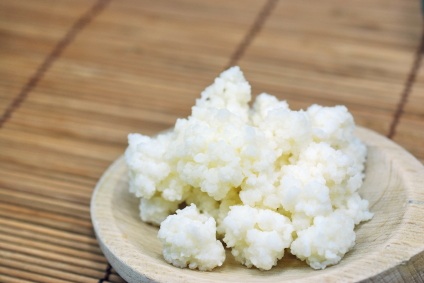Milk Kefir: What It Is & How to Brew It
 Email this Post |
Email this Post |  Print this Post |
Print this Post |  Add to Recipe Box | Share461
Add to Recipe Box | Share461 Milk kefir is, to put it lightly, an acquired taste. Sour and pungent, milk kefir is a cultured dairy food originally from the Caucuses – the region where Europe meets Asia. There it has been traditionally heralded as an elixer of long life and health. It seems that there’s wisdom in this tradition: milk kefir is rich in beneficial bacteria, phosphorus, vitamin K, biotin and folic acid – nutrients that are essential to health and well-being. A single component of milk kefir – kefiran – may prove particularly beneficial as it successfully protects beneficial bacteria from damage in the hostile environment of the digestive tract1.
Milk kefir is strongly anti-inflammatory2 and may prove helpful in combating gastro-intestinal distress caused by infections from bacillus cereus3, salmonella, e coli and helictobacter pylori4. Milk kefir is also particularly important in recovering from clostridium difficile infection and associated gastrointestinal discomfort and diarrhea which often accompanies use of antibiotics5. Despite the fact that milk kefir is, itself, a symbiotic colony of bacteria and yeasts (or SCOBY), milk kefir also acts as a powerful antimicrobial food – helping to limit the growth of pathogens while encouraging the proliferation of beneficial bacteria in the intestinal tract.
Milk kefir, like other cultured dairy foods, may also play a role in the prevention of cancer as it exhibits antitumoural effects6. Cultured dairy foods, including milk kefir, have been found to play a role in the prevention and treatment of bladder cancer7, breast cancer8 and colon cancer9. Indeed, some researchers have concluded that milk kefir may be one of the most promising foods when it comes to cancer prevention10.
Milk kefir is cultured from a symbiotic colony of bacteria and yeasts (SCOBY) that is coloquially referred to as kefir grains. The appearance of these small colonies of bacteria and yeast vaguely resembles that of cottage cheese or even cauliflower. Milk kefir grains are white, lumpy and gelatinous and are comprised primarily of lactic acid producing bacteria including lactobacillus brevis, streptococcus thermophillus, lactobacillus casei, lactobacillus helveticus, lactobacillus delbrueckii as well as yeasts that include candida maris, candida inconspicua and saccharomyces cerevisiae11. Though, of course, strains of bacteria present may differ from one culture of grains to another.
Obscure and exotic as it may seem, milk kefir is neither difficult to acquire nor difficult to prepare. As with many traditional foods, its beauty lies in its simplicity. It’s easy to begin preparing kefir and incorporating it into your family’s dietary rotation. Once you’ve acquired a kefir grains, simply mix them in with milk – preferably raw – and allow it to culture at room temperature for 24 – 48 hours. As it cultures at room temperature, the beneficial strains of bacteria and benign natural yeasts will proliferate, metabolize the milk’s lactose and create a sour, thick beverage replete with vitamins, probiotics, kefiran and other nourishing components. The longer milk kefir cultures the more sour and folate-rich it becomes, but take care not to culture it too long lest it become unpalatable.
Prepare Milk Kefir at Home
Preparing milk kefir at home is remarkably easy and quite affordable. It takes considerably less effort than homemade yogurt and homemade yogurt requires very little effort, indeed.
How to Use Milk Kefir
- Drink it Plain
- Mix it in a Smoothie
- As a Base for Homemade Ranch Dressing
- In Frozen Yogurt
- Over Oatmeal
- To Soak Grains
Milk Kefir: Equipment Needed
- 2 1-quart Sized Mason Jars with lid and band
- Small, nonmetal sieve or tea strainer
- Wooden Chop Stick or Small Wooden Whisk
Milk Kefir: Ingredients
- 1 Tablespoon Milk Kefir Grains (see sources)
- 1 Quart Fresh Raw Milk from Grassfed Cows
Milk Kefir: Instructions
- Place milk kefir grains in the bottom of a clean mason jar.
- Cover with 1 quart fresh milk.
- Very loosely, place the lid and band on the mason jar. You do not want to tighten it because, as with all fermentation, carbon dioxide is created and needs to escape.
- Culture for 24 – 48 hours at room temperature. For a for a thin, mild kefir you can culture for 12 hours.
- Once culturing is complete, strain milk kefir into a new mason jar, cap and refrigerate.
- Begin reculturing a new batch of kefir, if desired or allow your kefir grains to rest in water in the refrigerator for a few days until you’re ready to make kefir again.
Notes: Milk kefir must be recultured at least weekly to keep the kefir grains alive and proliferating. If you reculture your grains and take care of them, they will proliferate. Instead of throwing excess kefir grains away, consider giving them to friends, posting an offer at your local health food store or offering them free for shippin on the Cultures and Starters Exchange here at Nourished Kitchen. Spread the real food love!

No comments:
Post a Comment